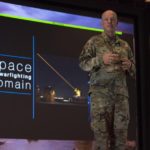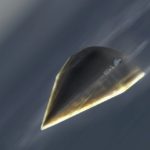Last August, acting secretary of the Air Force Matthew Donovan advocated for a separate U.S. Space Force. It looks like $15.4 Billion has been set aside for the new sub-division of the AirForce: SPACEFORCE.
According to insider gossip, Space Force might really be Starfleet Command like we always thought DARPA, US Space + Missile Command and the secret squirrels have dreamed.
If you’ve read Dr. Pournelle’s stuff for any length of time, you know how vital the high ground has been for the defense of the nation in his mind. There was always a long wish list. From project THOR in the 60’s, the Strategy of Technology in 1970, to the fantastical alien-fighting ships in FOOTFALL, to the shuttle explosion response of the Citizens Advisory Council on National Space Development, the proposed Star Wars SDI initiative or even quite rumblings of toward the DC/X, short for Delta Clipper or Delta Clipper Experimental; Jerry always sought to advance democracy through power in space.
Recently, our advisors have been warning us about extreme advances by a new foe in space: China.
 China in steady pursuit of space capabilities to outmatch U.S.
China in steady pursuit of space capabilities to outmatch U.S.
Pentagon Modernizing to Keep Pace with China
An artistic rendition of DARPA’s Hypersonic Technology Vehicle (HTV-2). The Chinese regime recently held its fourth test of a hypersonic missile. (DARPA)
To Defeat Hypersonic Weapons, Pentagon Aims To Build Vast Space Sensor Layer
To China’s land deployment, outer space must be added. A good illustration of the dynamics underway. In 2011, a US law excluded China from the International Space Station (ISS). Suddenly, it intends to build its own by 2025. In 2019, Beijing fired more rockets than any other country: 34 launchers, including 32 successfully (27 for the United States) and also, remember, placed a module on the far side of the moon. This implies many technological advances; as well as colossal investments (we will not deal here with the contractions or weaknesses of the Xi Jinping regime and their possible consequences).
Nothing is yet irreversible, but we have entered a very new situation with very uncertain consequences. Finally, you don’t have to be a soothsayer to understand that the China/US conflict can lead to an acceleration of the climate and worldwide economic crisis. Who is worrying about that in Washington or Beijing? Not SpaceForce. They are apolitical.
BECOME A MEMBER OF CHAOS MANOR
Here’s more from Donavan on his goals for Space Force:
 In June, Donavan publicly echoed President Donald Trump’s call for a U.S. Space Force, and I believe a separate service is the best way to protect the United States. America’s adversaries are fielding advanced weapons to attack U.S. space systems, and the consequence of losing in space would be catastrophic to America and our way of life. Congress understands the gravity of this threat and is preparing to conference legislation in the Fiscal Year 2020 National Defense Authorization Act to establish a U.S. Space Force.
In June, Donavan publicly echoed President Donald Trump’s call for a U.S. Space Force, and I believe a separate service is the best way to protect the United States. America’s adversaries are fielding advanced weapons to attack U.S. space systems, and the consequence of losing in space would be catastrophic to America and our way of life. Congress understands the gravity of this threat and is preparing to conference legislation in the Fiscal Year 2020 National Defense Authorization Act to establish a U.S. Space Force.
Although the House and Senate proposals differ in several ways, they fundamentally agree on two important facts: a new organization is required, and it should reside within the Department of the Air Force. I commend our Congressional partners for their action, but urge them to go one step further. Without modification to Title 10 of U.S. Code, the current legislative provisions do not establish a separate service and sixth branch of the U.S. armed forces. Congress should explicitly include the U.S. Space Force in Title 10 and codify it alongside its sister services in this bedrock law.
Changing Title 10 isn’t a meaningless formality or dull legislative exercise. It goes to the heart of our need for a separate service. It provides permanent and unambiguous recognition of its equal status, as well as the authorities to organize, train, and equip in order to provide trained and ready forces to combatant commanders. America needs a U.S. Space Force to dominate our adversaries, but it must be a new and separate service to realize its full potential.
We’ve already seen how space as an emerging warfighting domain demands a dedicated military service. Indeed, today’s space enterprise is at a historic moment analogous to airpower in World War I and the inter-war years. Early aircraft began as extensions of traditional military forces, and would evolve through competition in the air to become independent and strategic instruments of national power. Today’s military space architecture remains at the early stages of a similar evolution, and must continue along the path forged by its predecessor.
This history makes a unique and powerful argument for why we need a separate Space Force. It goes beyond debates over cost and bureaucracy, and brings us back to the fundamental purpose of a specialized military service. Today’s parallel with early airpower history demonstrates why our country needs a Space Force, and is central to understanding the necessity for Title 10 adjustments.
Over and Above the Enemy
Nearly 100 years ago, Billy Mitchell, the iconoclastic airpower proponent, led an experiment that would forever change the character of war. In July of 1921, Mitchell’s airmen successfully sank the SMS Ostfriesland, a World War I German battleship provided to the U. S. Navy as a spoil of war, using only bombs dropped from the air. Long believed an impossible task, the sinking of the Ostfriesland vindicated early airpower theorists and, more importantly, galvanized public belief in the promise of airpower. Ultimately, Mitchell’s quest for an independent air service would succeed 26 years later, following the decisive impact of airpower in the most devastating war in history.
We cannot overstate the enormity of Mitchell’s accomplishment. In 1903, only 18 years before the Ostfriesland experiment, became the first human to sustain heavier than air flight. Orville would fly for 12 seconds across 120 feet of North Carolina beach, piloting a primitive flying device designed in the Wright Brothers’ bicycle shop. Just over a decade later, stalemate on the battlefields of World War I would drive military leaders to search for new ways of observing their enemies. On the Western Front, miles of trenches and barbed wire prevented horse cavalry from tracking and reporting on enemy positions, so both sides turned to early aircraft to fill this military necessity.

Like every military invention, the first aircraft were initially used to improve existing practices and as adjuncts to other military forces. Comprised of little more than wood and cloth, these aircraft were used for reconnaissance and observation over long distances, to provide targeting “data” for artillery, and also helped communicate with disconnected infantry forces (even though the early lack of reliable radios limited this to air-dropped messages). However, less than a decade passed between the Wright Brothers’ first flight at Kitty Hawk and the employment bi-winged military aircraft. Less than another ten years passed before the United States and the great powers of Europe had plans on the drawing board for thousands of airplanes to use as instruments of national military power.
In contrast, the technology used to launch Sputnik 62 years ago is largely the same as that used to launch objects into orbit today. What has advanced is the technology we put into space: the advanced optical and other spectrum sensors, communication arrays, and navigation and timing payloads attached to our satellites. Even so, the state of our space programs today more closely resembles airpower in its infancy, where satellites serve largely as an enabling force for more traditional weapons systems and operations.
Like their wood and cloth predecessors, satellites perform many of the same early airpower missions — including intelligence, surveillance, and reconnaissance, communications, and indications and warning of adversary activity. Early reconnaissance satellites even dropped rolls of film for later development, harkening back to early pilots dropping messages scrawled on bits of paper. But the nation cannot afford to confine itself to viewing space power in the same way the Air Force’s Army forefathers viewed airpower; first as artillery observers and then as extended artillery itself. It took imaginative and forceful people to expand airpower’s full potential; the same will be needed for space.
From Airpower to Spacepower
Critically, we are witnessing the same transformation in space that we observed over the battlefields of Western Europe. Specifically, as airpower grew more important, it spawned efforts to competitively deny opponents their use of the air. Airpower entrepreneurs would go from waving at opposing pilots as they flew past, to firing revolvers and then machine guns at one another, extending the battle below into the skies above. The birth of aerial combat demonstrated how militaries would need to target enemy observation and communication systems, particularly those that flew or persisted above their heads.
Today, we’ve similarly witnessed adversary programs, tests, and research projects that all aim to attack our modern overhead and persistent observers: our satellites. In future conflicts we will face arsenals of anti-satellite missiles, directed energy weapons, cyber-attack capabilities, electronic warfare systems, and offensive satellites. Given the advantages we derive from space, it should be no surprise that our adversaries wish to deny us the use of this critically important domain.
To meet this challenge, we must recognize that space is a place wholly distinct from the atmosphere. It requires dedicated warfighting space professionals to meet these threats, just as early pioneers of the air needed to be freed from the shackles of two-dimensional dogma. We must finally and fully recognize that the movement, sustainment, and operation of aircraft differ from that of orbiting spacecraft. Though these realms both encircle the Earth, each requires vastly different expertise to employ or defend weapons systems from their respective domains.
Our early space program demonstrated these tremendous differences, particularly the flights that explored spacecraft rendezvous operations during Project Gemini. Pilots-turned-astronauts like Neil Armstrong, Ed White, and Jim McDivitt grappled with how the principles of spaceflight often inverted the lessons they learned flying aircraft. To catch up to another spacecraft they would need to paradoxically “slow down to speed up,” descending into a lower orbit that would take them faster around the Earth. The vast distances of space add a temporal dimension as well; maneuvering a combat aircraft to a position of advantage over the enemy takes seconds, but the same could take days or weeks in a spacecraft. However, the margin for fatal error is as narrow in both domains.
A New Service for a New Age
The Department of Defense and the Congress now have the opportunity to inaugurate an information age service, optimized to meet the challenges of the 21st century. Our youngest military service, the Air Force, was formed over a decade before the first primitive satellites would orbit the Earth. Today, space is changing from the benign environment of the past into a warfighting domain of great power competition.
To adapt to this challenge, we need a generation of space warfighters in a separate service that will give space the same attention and priority we accord the other physical domains. We need space warfighters to shape a unique culture that will craft innovative strategies and tactics to gain true “space superiority.” And we need space warfighters to field radically improved space capabilities and nurture the requisite independent space power theory and doctrine. Through this focus, we will provide the operating concepts and technological advantages we need to dominate any adversary who threatens us.
We can also build the U.S. Space Force as a 21st century military service. The Department of Defense still organizes around military service structures largely based on an older era of warfare. We need a flat, agile, and rapid space headquarters staff that can outpace the swift advancements of our adversaries, and stay inside of their decision cycles. We have an opportunity to design the U.S. Space Force from a blank slate, and potentially create a pathfinder to inspire the same reform across the other military services.
As we construct this service, we must build on the deep space expertise already found in the Air Force. Our airmen helped develop a space architecture that produced unparalleled advances in science, technology, economics, and warfare. Our society and military have transformed from these advances, and our substantial dependence on space is a testament to their success and dedication.
The future will require a community of space operators that harnesses our past triumphs while forging a new path. We must find and promote groundbreaking ideas for space, many of which may come from unlikely contributors. Indeed, Billy Mitchell was a communications officer in the U.S. Army Signal Corps, the breeding ground for our future pilot force. To foster these disruptive ideas, we can seed a fledgling space force with all manner of diverse experts and leaders from across the Department of Defense, from other domain warfighters to technologists and engineers; what innovative and dedicated national security professional wouldn’t want to participate in the building of such a historic force?
Reaching Beyond New Horizons
The nation needs to revive the spirit of our early airpower pioneers. Billy Mitchell foresaw the promise of an independent air force with unrivaled strategic reach, gestated by the spirit of an “aviation nation,” and fueled by a deep and enduring partnership with industry. The Ostfriesland lesson demonstrated that potential and drove the national conscience.
We need the same for our space community. It is high time to seek out and empower today’s Billy Mitchells to unapologetically advocate new theories of space warfare, even though they may be controversial, uncomfortable, and challenged by critics. We need to partner with the space industry to harness the technology and innovation they are rapidly developing. Spacepower needs its version of the Ostfriesland demonstration to show the possibilities from the ultimate high ground, and spark the development and potential of space power.
In order to properly meet the challenges posed by a rising China and Russia and to secure the systems upon which our national prosperity depends, America must have a separate Space Force. Beyond adding capability and expertise, this reform would unequivocally demonstrate to our adversaries that the United States is committed to preserving its dominance in space, and will strenuously uphold the international order against those that would seek to disrupt it.
What would the U.S. Air Force look like if it were still subordinated to the U.S. Army? Would it still have achieved the global vigilance, reach, and power dominance it holds today? Or would it still be largely comprised of systems and capabilities that enable purely army missions? A portrait of Billy Mitchell hangs in my office. As he gazes down on me day after day, I feel his impassioned plea to see past the limits of today’s policies and constrained thought, and strive confidently into the bright future of the United States Space Force.
I look forward to working with Congress as we stand up a modern, yet historic, Space Force. Let’s reform Title 10 and truly make the U.S. Space Force the newest branch of the armed forces our country needs to maintain our overmatch in the 21st century.
 China in steady pursuit of space capabilities to outmatch U.S.
China in steady pursuit of space capabilities to outmatch U.S.
If USAF had simply taken the strategic elements from the Army, there is nothing that happened with strategic transports and SAC that would not have happened. The Army would also have been better off with TacAir remaining under their control, as it should have been.